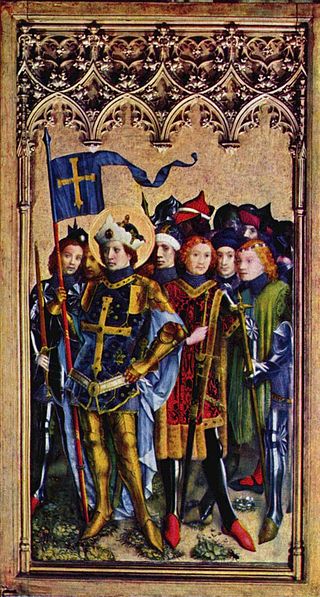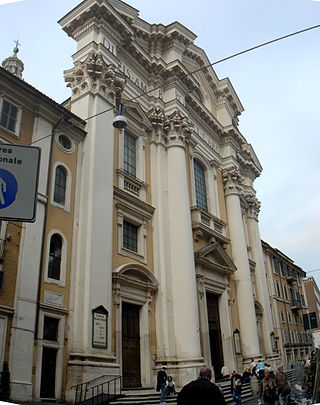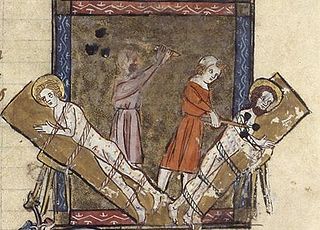Related Research Articles

Arona is a town and comune on Lake Maggiore, in the province of Novara. Its main economic activity is tourism, especially from Milan, France and Germany.

The Theban Legion figures in Christian hagiography as a Roman legion from Egypt—"six thousand six hundred and sixty-six men"— Christians who were martyred together in 286, according to the hagiographies of Maurice, the chief among the Legion's saints. Their feast day is held on September 22.

Sant'Ambrogio e Carlo al Corso is a basilica church in Rome, Italy, facing onto the central part of the Via del Corso. The apse of the church faces across the street, the Mausoleum of Augustus on Via di Ripetta.

May 31 - Eastern Orthodox Church calendar - June 2

Victor the Moor was a native of Mauretania and a Christian martyr, according to tradition, and is venerated as a saint.

Saints Gervasius and Protasius are venerated as Christian martyrs, probably of the 2nd century. They are the patron saints of Milan and of haymakers and are invoked for the discovery of thieves. Their feast day in the Latin Rite of the Catholic Church is 19 June, the day marking the translation of their relics. In the Eastern Orthodox Church and in the Eastern Rites of the Catholic Church, their feast takes place on 14 October (O.S.)/24 October (N.S.), the traditional day of their death. In Christian iconography their emblems are the scourge, the club and the sword.

The Four Crowned Martyrs or Four Holy Crowned Ones were nine individuals who are venerated as martyrs and saints of Early Christianity. The nine saints are divided into two groups:
- Severus, Severian(us), Carpophorus (Carpoforus), Victorinus
- Claudius, Castorius, Symphorian (Simpronian), Nicostratus, and Simplicius

Simplician was Bishop of Milan from 397 to 400 or 401 AD. He is honoured as a Saint in the Roman Catholic and Eastern Orthodox Churches and his feast day is August 14.
Carpophorus, Exanthus, Cassius, Severinus, Secundus and Licinius were Christian soldiers who, according to tradition, were martyred at Como during the reign of Maximian.

Alexander of Bergamo is the patron saint of Bergamo, as well as Capriate San Gervasio and Cervignano d'Adda. Alexander may have been a Roman soldier or resident of Bergamo who was tortured and killed for not renouncing his Christian faith. Details of his life are uncertain, but subsequent Christian stories consider him a centurion of the Theban Legion commanded by Maurice.

Fidelis of Como was an Italian soldier-saint, according to Christian tradition.

Perugia Cathedral is a Roman Catholic cathedral in Perugia, Umbria, central Italy, dedicated to Saint Lawrence. Formerly the seat of the bishops and archbishops of Perugia, it has been since 1986 the archiepiscopal seat of the Archdiocese of Perugia-Città della Pieve.

Saints Secundian(us), Marcellian and Verian are venerated as Christian saints. They were martyred in 250 AD near Civitavecchia or Santa Marinella during the persecutions of Decius. Secundian was a senator or some sort of prominent official; Marcellian and Verian were scholars or students. Their feast day is August 9.
Amantius of Como is venerated as the third bishop of Como. He was preceded by Felix of Como and Provinus. He was succeeded by Abundius. His feast day is 8 April.
Chiaffredo is venerated as the patron saint of Saluzzo, Italy. Tradition considers him a member of the Theban Legion, but instead of being martyred with this legion at Agaunum, he escaped to Piedmont and was martyred there.

Saint Magnus of Anagni, also known as Magnus of Trani or Magnus of Fabrateria Vetus, is venerated as the patron saint of Anagni.
Tegulus is venerated as a member of the legendary Theban Legion, whose members were led by Maurice in the 3rd century. The center of Tegulus' cult is at Ivrea. Veneration of Tegulus actually arose at the end of the 10th century, when during the episcopate of Warmondus (Varmondo), the Tegulus's relics were discovered in a sepulcher situated a short distance away from Ivrea. The relics were translated to the cathedral of Ivrea within the city walls, and placed in the chapel of San Giacomo. The relics were later translated, with those of Bessus, to the chapel of Santissimo Sacramento.

The Basilica of San Fedele in Como is located in the city center. The present Romanesque church dates from 1120 and is dedicated to the Fidelis of Como.

Santi Martiri also known as Chiesa di San Graziano is the Roman Catholic church located on a hill above Piazza San Graziano in the town of Arona, Province of Novara, Piedmont, Italy.
Fidelis is a given name and surname. The equivalent is Fidélis in Portuguese or Fidel in Spanish.
References
- ↑ Great Synaxaristes: (in Greek) Οἱ Ἅγιοι Φελινὸς καὶ Γρατινιανὸς οἱ Μάρτυρες. 1 Ιουνίου. ΜΕΓΑΣ ΣΥΝΑΞΑΡΙΣΤΗΣ.
- 1 2 Sabine Baring-Gould, The Lives of the Saints: June. (J. Hodges, 1874), 1.
- 1 2 3 4 5 Pomi, Damiano. "Santi Graziano e Felino, Carpoforo e Fedele"
- 1 2 "South transept spire", Duomo di Milano
- ↑ "Patron Saints Index: Saint Charles Borromeo". Archived from the original on 2003-12-28. Retrieved 2007-11-08.